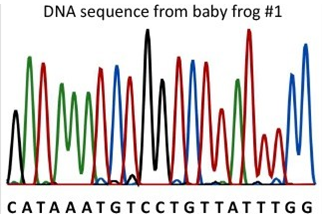Explain the difference between benign and malignant tumors
What will be an ideal response?
ANSWER: In benign tumors, the cells have dedifferentiated into a less specialized state. The cells remain
in a single mass and do not invade surrounding tissues. For this reason, they are generally not
life-threatening. Malignant tumors, in contrast, are disruptive to the surrounding tissues. Like
benign tumors, they are comprised of dedifferentiated cells. Due to the disruptive nature of
malignant tumors and their ability to metastasize, they are life-threatening.
You might also like to view...
Baby frog #1 was born with brown skin instead of the normal green. DNA was collected from the baby frog and the DNA sequence of part of gene B was determined using the primer 5? ACTCAAGCACAGGTCG 3?. What is the entire sequence of the smallest DNA fragment produced in the sequencing reaction? (See diagram for sequencing data.)

A) C
B) 5? ACTCAAGCACAGGTCGC
C) 5? AGGTCGG
D) 5? CATAAATGTCCTGTTATTTGG
E) 5? CGACCTG
Which of the following cells is NOT haploid?
a. secondary spermatocyte b. sperm c. primary oocyte d. spermatids e. polar bodies
The general types of membrane proteins are:
A. single pass proteins, multipass proteins, and peripheral proteins B. multipass proteins, lipid anchored proteins, and single pass proteins C. multipass proteins, lipid anchored proteins, and peripheral proteins D. peripheral proteins, integral proteins, and lipid anchored proteins. E. peripheral proteins, integral proteins, and enzymes
How do glomeromycetes benefit from their mutualistic relationships with plant hosts?
A. The plant delivers soil nutrients to the fungus. B. The plant provides water for the fungus. C. The plant protects the fungus from predation. D. The plant provides carbohydrates for the fungus.